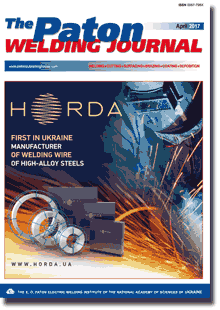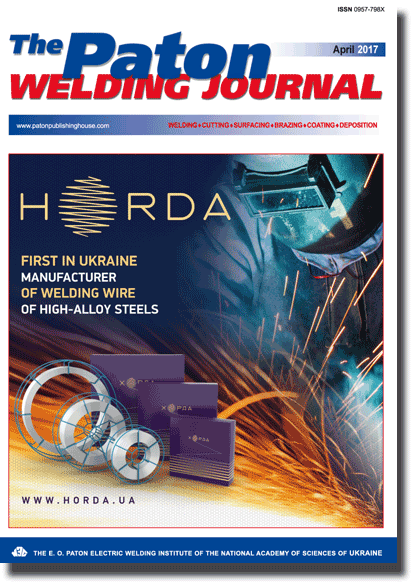| 2017 №04 (05) |
DOI of Article 10.15407/tpwj2017.04.06 |
2017 №04 (07) |

The Paton Welding Journal, 2017, #4, 30-34 pages
Comparative evaluation of methods of arc and hybrid plasma-arc welding of aluminum alloy 1561 using consumable electrode
V.N. Korzhik1,2, N.A. Pashchin2, O.L. Mikhoduj2, A.A. Grinyuk2, A.A. Babich1,2 and V.Yu. Khaskin1,2
1Guangdong Welding Institute (E.O. Paton Chinese-Ukrainian Institute of Welding), Guangzhou, PRC
2E.O. Paton Electric Welding Institute, NASU 11 Kazimir Malevich Str., 03680, Kiev, Ukraine. E-mail: office@paton.kiev.ua
Abstract
In addition to the traditional pulsed arc welding using consumable electrode at reverse polarity, it is advisable to apply hybrid plasma-arc welding using consumable electrode to increase the service life and reliability of welded structures of aluminum alloys. The works on determination of technological modes of hybrid plasma-arc welding of aluminum alloy 1561 of 5 mm thickness and the comparison of the processes of traditional consumable electrode arc welding and hybrid plasma-arc welding, taking into account the residual stress-strain state of the resulting butt welded joints, as well as evaluation of the prospects for replacement of traditional arc welding by hybrid one were carried out. During determination of technological modes of hybrid plasma-arc and pulsed arc welding of the aluminum alloy 1561, it was found that at the same speeds the both methods provide approximately equal energy input. At the same time the mastered technology of hybrid welding provided the reduction in the wire diameter from 1.6 to 1.2 mm, which resulted in 25–50 % smaller width of the weld as compared to arc welding. Reduction in the area of the weld facial part as compared to the root part area in the hybrid welding method led to approximately 3 times decrease in the level of residual distortion of welded plates, and 15–20 % decrease in residual stresses along the weld line. 6 Ref., 1 Table, 10 Figures.
Keywords: aluminum alloy, consumable electrode arc welding, hybrid plasma-arc welding, modes, speckle-interferometry, stress-strain state
Received: 15.02.17
Published: 17.04.17
References
- Khaskin, V.Yu. (2013) Development of laser welding of aluminium alloys at the E.O.Paton Electric Welding Institute (Review). The Paton Welding J., 5, 51–55.
- Zusin, V.Ya., Serenko, V.A. (2004) Welding and surfacing of aluminium and its alloys. Mariupol: Renata.
- Grinyuk, A.A., Korzhik, V.N., Shevchenko, V.E. et al. (2015) Main tendencies in development of plasma-arc welding of aluminium alloys. The Paton Welding J., 11, 31–41. https://doi.org/10.15407/tpwj2015.11.04
- Grinyuk, A.A., Korzhik, V.N., Shevchenko, V.E. et al. (2016) Hybrid technologies of welding aluminium alloys based on consumable electrode arc and constricted arc. Ibid., 5/6, 98–103. https://doi.org/10.15407/tpwj2016.06.17
- Shonin, V.A., Poklyatsky, A.G. (2001) Low-cycle fatigue of welded butt joints made from alloy AMg6 in inert atmosphere. Ibid., 3, 18–22.
- Lobanov, L.M., Pivtorak, V.A., Savitsky, V.V. et al. (2006) Procedure for determination of residual stresses in welded joints and structural elements using electron speckle-interferometry. Ibid., 1, 24–29.
Suggested Citation
V.N. Korzhik, N.A. Pashchin, O.L. Mikhoduj, A.A. Grinyuk, A.A. Babich and V.Yu. Khaskin (2017) Comparative evaluation of methods of arc and hybrid plasma-arc welding of aluminum alloy 1561 using consumable electrode. The Paton Welding J., 04, 30-34.The cost of subscription/purchase order journals or individual articles
| Journal/Currency | Annual Set | 1 issue printed |
1 issue |
one article |
| TPWJ/USD | 384 $ | 32 $ | 26 $ | 13 $ |
| TPWJ/EUR | 348 € | 29 € | 24 € | 12 € |
| TPWJ/UAH | 7200 UAH | 600 UAH | 600 UAH | 280 UAH |
| AS/UAH | 1800 UAH | 300 UAH | 300 UAH | 150 UAH |
| AS/USD | 192 $ | 32 $ | 26 $ | 13 $ |
| AS/EUR | 180 € | 30 € | 25 € | 12 € |
| SEM/UAH | 1200 UAH | 300 UAH | 300 UAH | 150 UAH |
| SEM/USD | 128 $ | 32 $ | 26 $ | 13 $ |
| SEM/EUR | 120 € | 30 € | 25 € | 12 € |
| TDNK/UAH | 1200 UAH | 300 UAH | 300 UAH | 150 UAH |
| TDNK/USD | 128 $ | 32 $ | 26 $ | 13 $ |
| TDNK/EUR | 120 € | 30 € | 25 € | 15 € |
AS = «Automatic Welding» - 6 issues per year;
TPWJ = «PATON WELDING JOURNAL» - 12 issues per year;
SEM = «Electrometallurgy Today» - 4 issues per year;
TDNK = «Technical Diagnostics and Non-Destructive Testing» - 4 issues per year.


